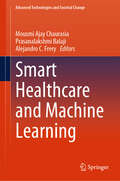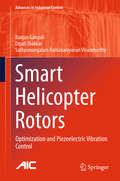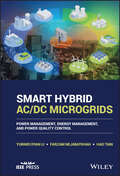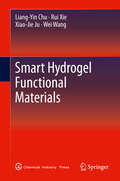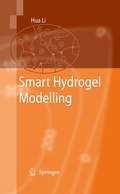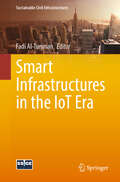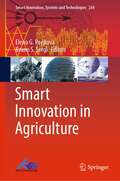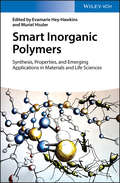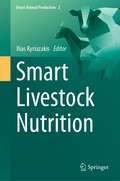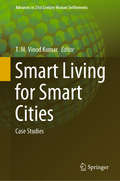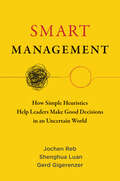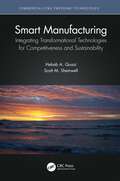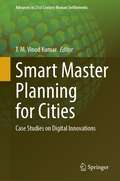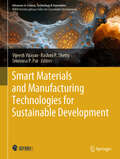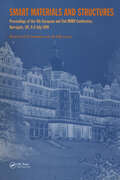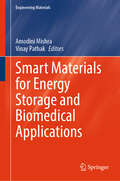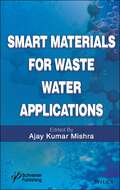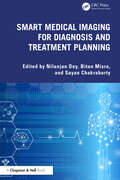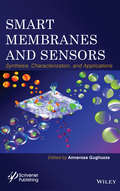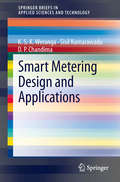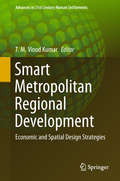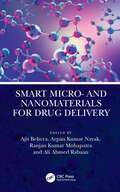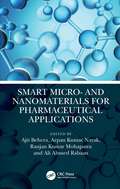- Table View
- List View
Smart Healthcare and Machine Learning (Advanced Technologies and Societal Change)
by Alejandro C. Frery Mousmi Ajay Chaurasia Prasanalakshmi BalajiThe book explores the convergence of healthcare and cutting-edge technology, making it a captivating subject for readers interested in future research. Smart healthcare with machine learning techniques offers a transformative paradigm that utilizes the power of new technology, data analytics, and interconnected devices to enhance the quality, efficiency, and accessibility of healthcare services. This involves leveraging Internet of Things (IoT) devices, wearable technology, and machine learning algorithms to monitor patient health, predict medical conditions, and offer personalized treatment recommendations. This innovative combination not only enhances diagnostics and treatment but also addresses the research challenges of healthcare access and delivery in an increasingly connected world. By exploring the synergy between smart healthcare and machine learning, the book helps to understand how these technologies can collaborate to revolutionize patient care and healthcare delivery. This book is an outcome with applications of future technologies to overcome the toughest humanitarian challenges from an engineering approach.
Smart Helicopter Rotors
by Ranjan Ganguli Dipali Thakkar Sathyamangalam Ramanarayanan ViswamurthyExploiting the properties of piezoelectric materials to minimize vibration in rotor-blade actuators, this book demonstrates the potential of smart helicopter rotors to achieve the smoothness of ride associated with jet-engined, fixed-wing aircraft. Vibration control is effected using the concepts of trailing-edge flaps and active-twist. The authors' optimization-based approach shows the advantage of multiple trailing-edge flaps and algorithms for full-authority control of dual trailing-edge-flap actuators are presented. Hysteresis nonlinearity in piezoelectric stack actuators is highlighted and compensated by use of another algorithm. The idea of response surfaces provides for optimal placement of trailing-edge flaps. The concept of active twist involves the employment of piezoelectrically induced shear actuation in rotating beams. Shear is then demonstrated for a thin-walled aerofoil-section rotor blade under feedback-control vibration minimization. Active twist is shown to be significant in reducing vibration caused by dynamic stall. The exposition of ideas, materials and algorithms in this monograph is supported by extensive reporting of results from numerical simulations of smart helicopter rotors. This monograph will be a valuable source of reference for researchers and engineers with backgrounds in aerospace, mechanical and electrical engineering interested in smart materials and vibration control. Advances in Industrial Control aims to report and encourage the transfer of technology in control engineering. The rapid development of control technology has an impact on all areas of the control discipline. The series offers an opportunity for researchers to present an extended exposition of new work in all aspects of industrial control.
Smart Hybrid AC/DC Microgrids: Power Management, Energy Management, and Power Quality Control (IEEE Press)
by Farzam Nejabatkhah Hao Tian Yunwei Ryan LiSMART HYBRID AC/DC MICROGRIDS Addresses the technical aspects and implementation challenges of smart hybrid AC/DC microgrids Hybrid AC/DC Microgrids: Power Management, Energy Management, and Power Quality Control provides comprehensive coverage of interconnected smart hybrid microgrids, their different structures, and the technical issues associated with their control and implementation in the next generation of smart grids. This authoritative single-volume resource addresses smart hybrid microgrids??? power management, energy management, communications, power converter control, power quality, renewable generation integration, energy storage, and more. The book contains both basic and advanced technical information about smart hybrid AC/DC microgrids, featuring a detailed discussion of microgrid structures, communication technologies, and various configurations of interfacing power converters and control strategies. Numerous case studies highlight effective solutions for critical issues in hybrid microgrid operation, control and power quality compensation throughout the text. Topics include control strategies of renewable energy and energy storage interfacing converters in hybrid microgrids, supervisory control strategies of interfacing power converters for microgrid power management and energy microgrid, and smart interfacing power converters for power quality control. This volume: Includes a thorough overview of hybrid AC/DC microgrid concepts, structures, and applications Discusses communication and security enhancement techniques for guarding against cyberattacks Provides detailed controls of smart interfacing power electronics converters from distributed generations and energy storage systems in hybrid AC/DC microgrids Provides details on transient and steady-state power management systems in microgrids Discusses energy management systems, hierarchical control, multi-agent control, and advanced distribution management control of smart microgrids Identifies opportunities to control power quality with smart interfacing power electronic converters Addresses power quality issues in the context of real-world applications in data centers, electric railway systems, and electric vehicle charging stations Smart Hybrid AC/DC Microgrids: Power Management, Energy Management, and Power Quality Control is a valuable source of up-to-date information for senior undergraduate and graduate students as well as academic researchers and industry engineers in the areas of renewable energy, smart grids, microgrids, and power electronics.
Smart Hydrogel Functional Materials
by Wei Wang Liang-Yin Chu Rui Xie Xiao-Jie JuSmart Hydrogel Functional Materials comprehensively and systematically describes our current understanding of smart or intelligent hydrogel functional materials with environmental stimuli-responsive functions. The contents range from hydrogels (including hydrogel-functionalized membranes) to microgels (including hydrogel-functionalized microcapsules) with various response properties, such as thermo-response, pH-response, pH-/thermo-dual-response, glucose-response, ethanol-response, ion-recognition, molecular-recognition, and so on. Most of the contents in this book represent the fresh achievements of the authors' group on smart hydrogel functional materials. While all chapters can be read as stand-alone papers, together they clearly describe the design concepts, fabrication strategies and methods, microstructures and performances of smart hydrogel functional materials. Vivid schematics and illustrations throughout the book enhance the accessibility of the theory and technologies involved. This is an ideal reference book for a broad general readership including chemists, materials researchers, chemical engineers, pharmaceutical scientists and biomedical researchers, who are interested in designing and fabricating smart hydrogel functional materials for various application purposes. Dr. Liang-Yin Chu is a professor at the School of Chemical Engineering, Sichuan University, China. He is a Distinguished Young Scholar of the National Natural Science Foundation of China and a Distinguished Professor of the "Chang Jiang Scholars Program" of the Ministry of Education of China.
Smart Hydrogel Modelling
by Hua LiThis is the first monograph of its kind, where a comprehensive and systematic description of modeling and simulation of the smart polymer hydrogels in BioMEMS environment is provided. It will cover the development of the models in form of nonlinear coupled partial differential governing equations for the smart hydrogels. Further, benchmark results, for simulation and prediction of responsive behaviour of the smart hydrogels to solution pH, externally applied electric voltage, environmental temperature, glucose/carbohydrates and salt concentration/ionic strength that are basic stimuli in common BioMEMS devices, are also documented. Finally, it is written in as simple a manner as possible, such that it will make informative and easy reading for the expert, and concurrently it can serve as a rich reference source for a graduate student intending to work in this area.
Smart Infrastructures in the IoT Era (Sustainable Civil Infrastructures)
by Fadi Al-TurjmanThis book provides a comprehensive overview of advanced digital disruptive technologies that can be used or currently used in Construction, and Smart Infrastructures. It provides a holistic collection of such disruptive technologies to address issues or otherwise uplift the technological aspects of various aspects of human lives and projects, impacting the overall culture and society sustainability. These pertinent technologies explored in this book are Artificial Intelligence (AI), Internet of Things (IoT), Unmanned Aerial Vehicles (UAVs), Clouds, and Big Data. It is expected that the book will unify the fields of construction and project management through the integration AI frameworks provided in various chapters.
Smart Innovation in Agriculture (Smart Innovation, Systems and Technologies #264)
by Elena G. Popkova Bruno S. SergiThis book is concerned with the systemic examination of the prospects for the development of smart agriculture for sustainable development. This book substantiates the top-priority significance of smart innovation in agriculture for modern economic and ecological systems. The book not only examines the theoretical concept of smart agriculture, but also gives consideration to the rule of thumb in terms of its implementation in different countries worldwide. The book contains both fundamental and applied recommendations on the innovative technological development of smart agriculture in modern economic and ecological systems for sustainable development. The book is not limited to a single vector of development of smart agriculture, but is representative of all of them, making it possible to describe the future prospects in the fullest, most reliable and accurate manner, and to comprehensively present the directions for its development. The book has developed and applied an advanced and sophisticated methodology, the advantage of which consists in the reliance on big data with the use of datasets, which allows improving accuracy, reliability, authenticity, and coverage of results.
Smart Inorganic Polymers: Synthesis, Properties, and Emerging Applications in Materials and Life Sciences
by Evamarie Hey-Hawkins Muriel HisslerProvides complete and undiluted knowledge on making inorganic polymers functional This comprehensive book reflects the state of the art in the field of inorganic polymers, based on research conducted by a number of internationally leading research groups working in this area. It covers the synthesis aspects of synthetic inorganic polymers and looks at multiple inorganic monomers as building blocks, which exhibit unprecedented electronic, redox, photo-emissive, magnetic, self-healing and catalytic properties. It also looks at the applications of inorganic polymers in areas such as optoelectronics, energy storage, industrial chemistry, and biology. Beginning with an overview of the use of smart inorganic polymers in daily life, Smart Inorganic Polymers: Synthesis, Properties and Emerging Applications in Materials and Life Sciences goes on to study the synthesis, properties, and applications of polymers incorporating different heteroelements such as boron, phosphorus, silicon, germanium, and tin. The book also examines inorganic polymers in flame-retardants, as functional materials, and in biology. -An excellent addition to the polymer scientists' and synthetic chemists' toolbox -Summarizes the state of the art on how to make and use functional inorganic polymers?from synthesis to applications -Edited by the coordinator of a highly funded European community research program (COST action) that focuses specifically on the exploration of inorganic polymers -Features contributions from top experts in the field Aimed at academics and industrial researchers in this field, Smart Inorganic Polymers: Synthesis, Properties and Emerging Applications in Materials and Life Sciences will also benefit scientists who want to get a better overview on the state-of-the-art of this rapidly advancing area.
Smart Livestock Nutrition (Smart Animal Production #1)
by Ilias KyriazakisThis book highlights the latest findings and techniques related to nutrition and feed efficiency in animal agriculture. It addresses the key challenges facing the nutrition industry to achieve high animal productivity with minimal environmental impact. The concept of smart nutrition involves the use of smart technologies in the feeding and management of livestock.The first chapters focus on advances in biological fields such as molecular agriculture and genotype selection, as well as technologies that enhance or enable the collection of relevant information. The next section highlights applications of smart nutrition in a variety of livestock systems, ranging from intensive indoor housing of broilers and pigs to extensive outdoor housing of cattle and sheep, and marine fish farms. Finally, because of the worldwide attention to this issue, the authors address the environmental consequences.This work, which takes a serious look at how nutrition can be used to improve sustainability in animal agriculture, is a key literature for readers in animal and veterinary sciences, the food industry, sustainability research, and agricultural engineering.
Smart Living for Smart Cities: Case Studies (Advances in 21st Century Human Settlements)
by T. M. Vinod KumarThis book, based on extensive international collaborative research, highlights the state-of-the-art design of “smart living” for metropolises, megacities, and metacities, as well as at the community and neighbourhood level. Smart living is one of six main components of smart cities, the others being smart people, smart economy, smart environment, smart mobility and smart governance. Smart living in any smart city can only be designed and implemented with active roles for smart people and smart city government, and as a joint effort combining e-Democracy, e-Governance and ICT-IoT systems. In addition to using information and communication technologies, the Internet of Things, Internet of Governance (e-Governance) and Internet of People (e-Democracy), the design of smart living utilizes various domain-specific tools to achieve coordinated, effective and efficient management, development, and conservation, and to improve ecological, social, biophysical, psychological and economic well-being in an equitable manner without compromising the sustainability of development ecosystems and stakeholders. This book presents case studies covering more than 10 cities and centred on domain-specific smart living components. The book is issued in two volumes. and this volume focus on city studies.
Smart Living for Smart Cities: Community Study, Ways and Means (Advances in 21st Century Human Settlements)
by T. M. Vinod KumarThis book, based on extensive international collaborative research, highlights the state-of-the-art design of smart living for metropolises, megacities, and metacities, as well as at the community and neighbourhood level. Smart living is one of six main components of smart cities, the others being smart people, smart economy, smart environment, smart mobility and smart governance. Smart living in any smart city can only be designed and implemented with active roles for smart people and smart city government, and as a joint effort combining e-Democracy, e-Governance and ICT-IoT systems. In addition to using information and communication technologies, the Internet of Things, Internet of Governance (e-Governance) and Internet of People (e-Democracy), the design of smart living utilizes various domain-specific tools to achieve coordinated, effective and efficient management, development, and conservation, and to improve ecological, social, biophysical, psychological and economic well-being in an equitable manner without compromising the sustainability of development ecosystems and stakeholders. This book presents case studies covering more than 10 cities and centred on domain-specific smart living components. The book is issued in two volumes and this volume focus on community studies and ways and means.
Smart Management: How Simple Heuristics Help Leaders Make Good Decisions in an Uncertain World
by Gerd Gigerenzer Jochen Reb Shenghua LuanWhy successful leaders must embrace simple strategies in an increasingly uncertain and complex world.Making decisions is one of the key tasks of managers, leaders, and professionals. In Smart Management, Jochen Reb, Shenghua Luan, and Gerd Gigerenzer demonstrate how business leaders can utilize heuristics—simple decision-making strategies adapted to the task at hand. In a world that has become increasingly volatile, uncertain, complex, and ambiguous (VUCA), the authors make the case against complex analytical methods that quickly reach their limits. This against-the-grain approach leads to decisions that are not only faster but also more accurate, transparent, and easier to learn about, communicate, and teach. Smart Management offers an evidence-based yet practical discussion of how business leaders can use smart heuristics to make good decisions in a VUCA world.Building on the fast-and-frugal heuristics program, Smart Management demonstrates the efficacy of heuristic decision making in a twofold approach. First, it introduces the concept of ecological rationality, which prescribes the environmental conditions under which specific heuristics work well. Second, the book describes a repertoire of heuristics, referred to as the adaptive toolbox, that leaders, managers, and professionals can develop and rely on to make a variety of decisions, such as on business strategy, negotiation, and personnel selection. The toolbox not only showcases the practical usefulness of these heuristics but also inspires readers to discover and develop their own smart heuristics.
Smart Manufacturing: Integrating Transformational Technologies for Competitiveness and Sustainability (Commercializing Emerging Technologies)
by Hebab A. Quazi Scott M. ShemwellThe manufacturing industries remain the foundation of local, regional, and global economies. Manufacturing plants operate in dynamic markets that demand upgrading with transformational technologies for maintaining profitability, competitiveness, and business sustainability. Yet most manufacturing plants currently use technologies that are no longer competitive, and industry leaders face an overwhelming array of operational challenges that require agile and enhanced transformational solutions. This book offers manufacturers effective strategies and tools for the adoption and implementation of advanced operational technologies to ensure long-term innovation, efficiency, and profitability. Covers advanced automation integration in manufacturing, including digitization, AI, machine learning, IIoT, and cybersecurity Describes innovation, development, and integration of control technologies for sustainable manufacturing Explains how to upgrade existing manufacturing plants for the global market Shows how to apply emerging technologies including asset optimization and process integration for product lifecycle improvements, plant operation and maintenance enhancement, and supply chain integration This book serves as a strategic guide to applying advanced operational technologies for engineers, industry professionals, and management in the manufacturing sector.
Smart Master Planning for Cities: Case Studies on Digital Innovations (Advances in 21st Century Human Settlements)
by T. M. Vinod KumarThis book, based on international collaborative research, presents a state-of-the-art design for “Smart Master Planning” for all metropolises, megacities and metacities as well as at subcity zonal and community and neighborhood level. Smart Master Planning accepts that all cities are a smart city in making in a limited way as far as the six components for smart cities, namely smart people, smart economy, smart environment, smart mobility and smart governance are concerned. Smart Master Planning in any city can only be designed and executed by active roles of smart people and smart city government and is a joint and synchronous effort of e-democracy, e-governance and ICT-IOT system in a 24 hour 7-day framework on all activities. In addition to use of information and communication technologies and remote sensing, the design of Smart Master Planning utilizes domain-specific tools of many aspects of a city to realize the coordinated, effective and efficient planning, management, development and conservation that improve ecological, social, biophysical, psychological and economic wellbeing in an equitable manner without compromising the sustainability of development ecosystems and stakeholders. This book will present 12 case studies covering more than 12 cities or more cities centered on domain-specific smart planning components.Case studies of digital innovations in the Smart Master Planning include Application of Artificial Neural Network in Master Planning for cities, Smart Master Plan and 3 D GIS Planning Support System and Digital Spatial Master Planning Incorporating Machine to Machine Automation for Smart Economic Community (IoT, ICT and M2M based Digital Integration).
Smart Master Planning for Cities: Case Studies on Domain Innovations (Advances in 21st Century Human Settlements)
by T. M. Vinod KumarThis book, based on international collaborative research, presents a state-of-the-art design for “Smart Master Planning” for all metropolises, megacities and meta cities as well as at sub-city zonal and community and neighborhood level. Smart Master Planning accepts that all cities are a smart city in making in a limited way as far as the six components for Smart Cities; namely, smart people, smart economy, smart environment, smart mobility and smart Governance are concerned. Smart Master Planning in any city can only be designed and executed by active roles of Smart People and Smart City Government and is a joint and synchronous effort of E-Democracy, E-Governance and ICT-IOT system in a 24 hour 7-day framework on all activities. In addition to use of Information and Communication Technologies, and Remote Sensing, the design of smart Master Planning utilizes domain specific tools of many aspects of a city to realize the coordinated, effective and efficient planning, management, development and conservation that improve ecological, social, biophysical, psychological and economic well-being in an equitable manner without compromising the sustainability of development ecosystems and stakeholders. This book will present 12 case studies covering more than 12 cities or more cities centered on domain-specific smart planning components.Case studies of Domain Innovations include Urban Land management, Master Planning for Water Management, Comprehensive Master Planning Innovations, Smart Use of Master Plan basics, Integrated Smart Master Planning, and Citizen-Centric Master Planning.
Smart Materials and Manufacturing Technologies for Sustainable Development (Advances in Science, Technology & Innovation)
by Vijeesh Vijayan Rashmi P. Shetty Srinivasa P. PaiThis book offers a comprehensive exploration of " Smart Materials and Manufacturing Technologies for Sustainable Development “delves into the dynamic intersection of innovative materials, intelligent manufacturing, and sustainable practices, presenting a vital resource for researchers, engineers, and professionals seeking to shape a greener and more advanced future. Covering a wide range of topics, the book delves into the latest advancements in materials processing, with a particular focus on cutting-edge technologies such as advanced manufacturing, nanotechnology, and materials. The book addresses the pressing need for sustainable manufacturing practices, unveiling eco-friendly approaches that reduce environmental impact without compromising performance. Chapters dedicated to artificial intelligence and machine learning illuminate how these game-changing technologies facilitate manufacturing, materials characterization, and process optimization. By integrating IoT, Industry 4.0, robotics, and automation, this book highlights the growing synergy between intelligent manufacturing and sustainable materials, paving the way for increased efficiency and productivity. It examines the importance of advanced materials characterization techniques, empowering researchers to gain deeper insights into materials' properties, behaviour, and potential applications. With its multidisciplinary approach, this book appeals to a diverse audience, including materials scientists, manufacturing engineers, environmentalists, policymakers, and students eager to contribute to a more sustainable and technologically advanced society.
Smart Materials and Structures: Proceedings of the 4th European and 2nd MIMR Conference, Harrogate, UK, 6-8 July 1998
by G R Tomlinson W A BulloughSignificant changes have occurred in materials science, including increasing demands on life extensions, and the reliability and exploitability of components, materials, and structures. These changes provide smart technologies with excellent application opportunities in aerospace, civil and electrical engineering, transportation, manufacturing, com
Smart Materials for Energy Storage and Biomedical Applications (Engineering Materials)
by Amodini Mishra Vinay PathakThis book brings together a curated selection of research in the broad field of smart materials, emphasizing their properties, functionality, and transformative potential. Covering diverse applications, from energy systems to biomedical advancements, it offers a snapshot of current innovations across multiple disciplines. The chapters begin with an introduction to smart material properties and their applications, progressing to in-depth discussions on topics like magnetocaloric effects in pyrochlore oxides, topological insulators, and magnetoelectric perovskites. Key studies examine magnetic nanoparticles for cancer biology, soft materials for sustainable technologies, and Pb-free perovskite ceramics with giant dielectric constants. Advanced research on nano-structured materials, material oxides in thin-film technologies, and photonic crystals further enrich this collection. A special focus is given to topological spin textures, such as skyrmions, and their applications in spintronic devices. From theoretical models to experimental insights, this book encompasses a wide range of topics that appeal to both established scientists and emerging researchers.
Smart Materials for Waste Water Applications
by Ajay Kumar MishraSmart materials are used to develop more cost-effective and high-performance water treatment systems as well as instant and continuous ways to monitor water quality. Smart materials in water research have been extensively utilized for the treatment, remediation, and pollution prevention. Smart materials can maintain the long term water quality, availability and viability of water resource. Thus, water via smart materials can be reused, recycled, desalinized and also it can detect the biological and chemical contamination whether the source is from municipal, industrial or man-made waste. The 15 state-of-the-art review chapters contained in this book cover the recent advancements in the area of waste water, as well as the prospects about the future research and development of smart materials for the waste water applications in the municipal, industrial and manmade waste areas. Treatment techniques (nanofiltration, ultrafiltration, reverse osmosis, adsorption and nano-reactive membranes) are also covered in-depth. The chapters are divided into three groups: The first section includes the various carbon nanomaterials (such as carbon nanotubes, mixed oxides) with a focus on use of carbon at nanoscale applied for waste water research. The second section focuses on synthetic nanomaterials for pollutants removal. The third section highlights the bio-polymeric nanomaterials where the authors have used the natural polymers matrices in a composite and nanocomposite material for waste treatment. The large number of researchers working in the area will benefit from the fundamental concepts, advanced approaches and application of the various smart materials towards waste water treatment that are described in the book. It will also provide a platform for the researchers and graduate students to carry out advanced research and understand the building blocks.
Smart Medical Imaging for Diagnosis and Treatment Planning
by Nilanjan Dey, Bitan Misra, and Sayan ChakrabortyThis book presents advanced research on smart health technologies, focusing on the innovative transformations in diagnosis and treatment planning using medical imaging and data analysed by data science techniques. It shows how smart health technologies leverage artificial intelligence (AI) and big data analytics to provide more accurate and efficient diagnosis and treatment planning. In search for innovative and novel methods and techniques for health technologies and medical data processing, the book • Discusses applications of Artificial Intelligence, Data Science, Machine Learning, Deep Learning, the Internet of Things, Big Data, Cloud Computing;• Includes use of electronic patient records in healthcare, analysis of big data in medical diagnosis, reliability, and challenges of EPR and EHR in smart healthcare;• Explores evolving techniques for smart healthcare, its application in medical imaging and prediction in the fields of treatment planning;• Provides recent studies in AI-driven healthcare technologies and medical imaging to outline insight into smart healthcare technologies;• Discusses the role of big data in smart healthcare, computing techniques for healthcare for medical diagnosis and treatment planning;• Encompasses the ethical and legal challenges of using smart healthcare and medical data.This book serves as a valuable reference for researchers working on smart health technologies. Researchers of medical imaging, artificial intelligence, and data science along with healthcare domain will find it a great resource as well.
Smart Membranes and Sensors
by Annarosa GugliuzzaThis book facilitates the access to the various disciplines, highlighting their many points of contacts and making the clear the message that membrane-based sensors represent the future of the research in every field, including chemistry, biology, biomedicine, textiles, and electronics.
Smart Metering Design and Applications
by K.S.K Weranga Sisil Kumarawadu D. P. ChandimaTaking into account the present day trends and the requirements, this Brief focuses on smart metering of electricity for next generation energy efficiency and conservation. The contents include discussions on the smart metering concepts and existing technologies and systems as well as design and implementation of smart metering schemes together with detailed examples.
Smart Metropolitan Regional Development: Economic And Spatial Design Strategies (Advances in 21st Century Human Settlements)
by T.M. Vinod KumarThis book discusses the concept and practice of a smart metropolitan region, and how smart cities promote healthy economic and spatial development. It highlights how smart metropolitan regional development can energize, reorganize and transform the legacy economy into a smart economy; how it can help embrace Information and Communications Technology (ICT); and how it can foster a shared economy. In addition, it outlines how the five pillars of the third industrial revolution can be achieved by smart communities. In addition, the book draws on 16 in-depth city case studies from ten countries to explore the state of the art regarding the smart economy in smart cities – and to apply the lessons learned to shape smart metropolitan economic and spatial development.
Smart Micro- and Nanomaterials for Drug Delivery (Emerging Materials and Technologies)
by Ajit Behera Arpan Kumar Nayak Ranjan K. Mohapatra Ali Ahmed RabaanSmart drug delivery at both the micro- and nanoscale is an evolving field with numerous potential applications. It has the potential to revolutionize drug therapy by making treatments more effective, reducing side effects, and improving patient outcomes.This book presents a comprehensive review of the most recent studies on smart micro- and nanomaterials with a focus on their “smart” activity for formation of targeted and responsive drug-delivery carriers. This volume: Introduces readers to the fundamentals of these the micro- and nanoscale materials as well as approaches to smart drug delivery and drug delivery systems. Covers polymers, metals, and composite materials as well as quantum dots and carbon nanotubes. Describes of all possible stimulated systems for drug delivery such as enzyme-responsive, small molecules-responsive, thermo-responsive, pH-responsive, electric field-responsive, magnetic field-responsive, light-responsive, ultrasound-responsive, and reductive environment responsive. Offers a critical perspective on the future scope of smart drug delivery systems. This reference work is written to support researchers in the fields of materials engineering and biotechnology with the goal of improving the diagnosis and treatment of disease and patient quality of life.
Smart Micro- and Nanomaterials for Pharmaceutical Applications (Emerging Materials and Technologies)
by Ajit Behera Arpan Kumar Nayak Ranjan K. Mohapatra Ali Ahmed RabaanSmart drug delivery refers to a targeted drug delivery or precision drug delivery system that allows drugs to be administered to a specific location in the body or at a specific time with enhanced precision and control. This approach has several advantages, including maximizing the therapeutic effects of a drug while minimizing side effects.This book presents various stimuli-responsive micro- and nanomaterials for pharmaceutical industries. This volume: Covers the global market perspective of micro- and nano-smart materials in pharmaceutical industries. Details various processing routes. Discusses mechanisms for target release. Addresses applications in oral drug delivery, anticancer agents, anti-tumor drug delivery, and drugs for management of infection. This reference work is written to support researchers in the fields of materials engineering and biotechnology with the goal of improving the diagnosis and treatment of disease and patient quality of life.
